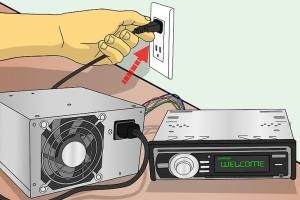Ultimate Guide: How to Use a Car Stereo at Home with a PSU

-
Quick Links:
- Introduction
- Understanding Car Stereos
- Why Use a Car Stereo at Home?
- Choosing the Right PSU
- Tools You Will Need
- Step-by-Step Guide to Connect Car Stereo
- Common Issues and Solutions
- Case Studies
- Expert Insights
- Conclusion
- FAQs
Introduction
In a world where technology constantly evolves, the desire to repurpose car audio equipment for home use has gained popularity. Car stereos are designed for optimal sound performance in vehicles, but they can also provide an excellent audio experience at home. This guide will walk you through the process of connecting a car stereo to a power supply unit (PSU), ensuring you can enjoy your favorite tunes in the comfort of your living room.
Understanding Car Stereos
Car stereos are compact audio systems designed to fit within the confines of a vehicle. They typically include features like Bluetooth connectivity, AM/FM radio, CD players, and USB inputs. Understanding the basic components of a car stereo is crucial for a successful home setup.
- Head Unit: The central control unit that houses all audio controls.
- Amplifier: Boosts the audio signal to enhance sound quality.
- Speakers: The output devices that produce sound.
Why Use a Car Stereo at Home?
Using a car stereo at home has several advantages:
- Cost-effective: Repurposing an existing device saves money.
- High-quality audio: Car stereos often have superior sound quality compared to standard home systems.
- Compact design: Ideal for small spaces where traditional home audio systems may not fit.
Choosing the Right PSU
The PSU is a crucial component for powering your car stereo at home. When selecting a PSU, consider the following:
- Voltage: Most car stereos operate on 12V, so ensure your PSU matches this specification.
- Amperage: Check the stereo's power requirements to choose a PSU that can deliver sufficient current.
- Quality: Opt for a reliable PSU from a reputable brand to avoid electrical issues.
Tools You Will Need
Before you start the installation process, gather the following tools:
- Wire Strippers
- Screwdriver
- Electrical Tape
- Soldering Iron (optional)
- Multimeter
Step-by-Step Guide to Connect Car Stereo
Follow these detailed steps to connect your car stereo for home use:
Step 1: Gather Your Equipment
Ensure you have your car stereo, PSU, tools, and any necessary wiring or connectors.
Step 2: Prepare the Power Supply
Set up your PSU in a well-ventilated area. Connect the PSU to a power outlet, ensuring it is turned off before proceeding.
Step 3: Connect the Wiring
Identify the power and ground wires from your car stereo:
- Red Wire: Power (+)
- Black Wire: Ground (-)
Use wire strippers to expose the ends of the wires, then connect them to the PSU:
- Connect the red wire to the positive terminal of the PSU.
- Connect the black wire to the negative terminal of the PSU.
Step 4: Connect the Speakers
Attach the speakers to the car stereo's output terminals. Ensure that the connections are secure and that you match positive and negative terminals correctly.
Step 5: Test the Setup
Turn on the PSU and then the car stereo. Check for any issues with sound or power. Use a multimeter if necessary to ensure correct voltage.
Common Issues and Solutions
Here are some common issues you might encounter and how to solve them:
- No Sound: Check connections and ensure the PSU is supplying power.
- Distorted Sound: Verify speaker connections and check for shorts.
- PSU Overheating: Ensure it has proper ventilation and is not overloaded.
Case Studies
Many users have successfully converted their car stereos for home use. Here are two case studies:
Case Study 1: Budget-Friendly Setup
A college student used an old car stereo and a $20 PSU to create an affordable sound system for their dorm. They reported great sound quality and ease of setup.
Case Study 2: High-End Audio Experience
A music enthusiast connected a high-end car stereo with a premium PSU, achieving an unparalleled audio experience at home. They noted that the sound quality rivaled that of traditional home audio systems.
Expert Insights
Experts recommend ensuring all connections are secure and investing in quality components to avoid issues. Regular maintenance of the PSU and stereo can prolong their lifespan.
Conclusion
Connecting a car stereo for home use with a PSU is a straightforward process that enhances your audio experience. By following this guide, you can enjoy superior sound quality without breaking the bank.
FAQs
- Can I use any car stereo at home? Yes, as long as you have the appropriate PSU.
- What is the best PSU for a car stereo? A PSU that delivers 12V and sufficient amperage for your specific stereo model.
- Do I need special tools? Basic tools like wire strippers and screwdrivers will suffice.
- Can I connect multiple speakers? Yes, but ensure the PSU can handle the load.
- Is it safe to use a car stereo at home? Yes, if properly connected and maintained.
- What if my stereo doesn’t power on? Check all connections and ensure the PSU is functioning.
- How do I improve sound quality? Consider upgrading speakers or using an external amplifier.
- Can I connect my phone to the stereo? Yes, if your stereo has Bluetooth or an auxiliary input.
- What about warranties? Modifying the stereo may void its warranty.
- Any tips for troubleshooting? Always double-check connections and consult the stereo’s manual for guidance.
Random Reads
- Windows xp repair install
- How to set time date digital watch
- How to remove glue from counter tops
- How to remove glass from garbage disposal
- How to turn off siri
- How to send code snippets on telegram
- How to send faxes from gmail
- How to share apps on android bluetooth
- Remove apple id phone number
- Remove free u2 album iphone